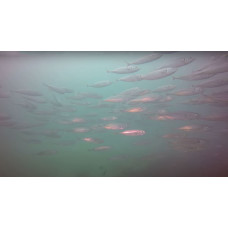Latin name
Trachurus murphyi
Other names
Inca scad, peruvian jack mackerel.
Identification
They have an elongated and laterally compressed body. The head is large, with well-developed transparent protective membranes (fat eyelids) covering the eyes. The mouth is also large, the posterior edge of the lower jaw coinciding with the anterior edge of the eyes. The fish have small teeth. The posterior edge of each of the gill covers has a distinct notch. They have two strong spines in front.
Features of fish fins
The second dorsal fin is much longer than the first. Pectoral fins are long and pointed. The pelvic fins begin below the lowest point of attachment of the pectoral fins. The anal fin is also long, but shorter than the second dorsal fin. Dorsal rays (total): 9; Dorsal soft rays (total): 31-35; Anal spines: 3; Anal soft rays: 27-29.
Fish colouring
The upper parts of the body are painted metallic blue, while the lower parts are painted silver white.
Distribution
Found in the South Pacific off Chile and Peru, around New Zealand and South Australia, and in a band across the open ocean between them. The range extends from 35° to 45° south latitude, which means it is 10° wide from north to south (about 1,100 km).
Habitat
Marine pelagic-oceanic oceanodromous subtropical species. Depth range 10 to 306 m, usually 10 to 70 m. Swims in schools off shore and in the open ocean.
Size
Length is usually 18 inches (45 centimeters), although fish can grow to 28 inches (70 centimeters). Can live up to 16 years.
Behavior
Adults are found in schools along the coast and in open ocean waters.
Food and feeding habits
They feed mainly on fish larvae, shrimp and other small crustaceans such as paddlefish, although they will also eat squid and small fish.
Reproduction
Chilean mackerel usually spawn in the summer. Their eggs are pelagic, meaning they float freely in the open ocean.
Fishing
Commercially, it is caught with volumetric nets designed for small pelagic purse seines or deep-sea trawls, or by trolling or longlining.
Relationship with a person
Chilean horse mackerel is canned or sold fresh for human consumption. It is a staple food in Africa. They are also used to make fishmeal.
| Classification | |
| Phylum | Chordata |
| Class | Actinopterygii |
| Squad | Carangiformes |
| Family | Carangidae |
| Genus | Trachurus |
| Species | T. murphyi |
| Features | |
| Conservation status | Data Deficient |
| Habitat | Pelagic |
| Life span, years | 16 |
| Maximum body weight, kg | No information |
| Maximum length, cm | 70 |
| Sailing speed, m/s | No information |
| Threat to people | Edible |
| Way of eating | Predator |
Chilean jack mackerel
Tags: chilean jack mackerel

